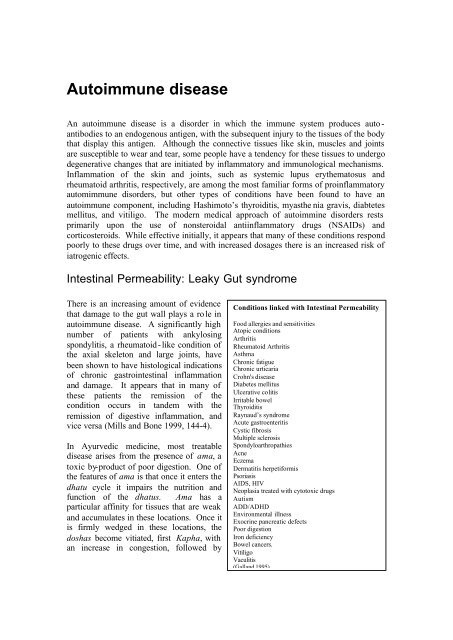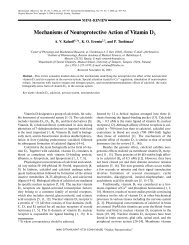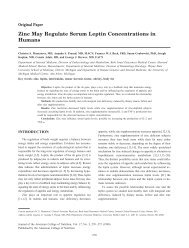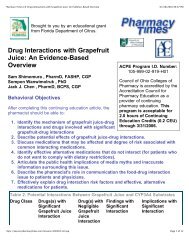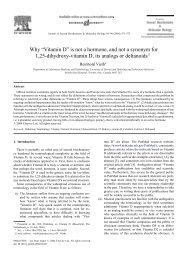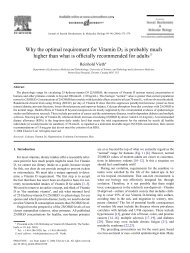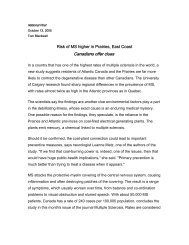Herbs and leaky gut - Direct-MS
Herbs and leaky gut - Direct-MS
Herbs and leaky gut - Direct-MS
Create successful ePaper yourself
Turn your PDF publications into a flip-book with our unique Google optimized e-Paper software.
Autoimmune disease<br />
An autoimmune disease is a disorder in which the immune system produces auto -<br />
antibodies to an endogenous antigen, with the subsequent injury to the tissues of the body<br />
that display this antigen. Although the connective tissues like skin, muscles <strong>and</strong> joints<br />
are susceptible to wear <strong>and</strong> tear, some people have a tendency for these tissues to undergo<br />
degenerative changes that are initiated by inflammatory <strong>and</strong> immunological mechanisms.<br />
Inflammation of the skin <strong>and</strong> joints, such as systemic lupus erythematosus <strong>and</strong><br />
rheumatoid arthritis, respectively, are among the most familiar forms of proinflammatory<br />
automimmune disorders, but other types of conditions have been found to have an<br />
autoimmune component, including Hashimoto’s thyroiditis, myasthe nia gravis, diabtetes<br />
mellitus, <strong>and</strong> vitiligo. The modern medical approach of autoimmine disorders rests<br />
primarily upon the use of nonsteroidal antiinflammatory drugs (NSAIDs) <strong>and</strong><br />
corticosteroids. While effective initially, it appears that many of these conditions respond<br />
poorly to these drugs over time, <strong>and</strong> with increased dosages there is an increased risk of<br />
iatrogenic effects.<br />
Intestinal Permeability: Leaky Gut syndrome<br />
There is an increasing amount of evidence<br />
that damage to the <strong>gut</strong> wall plays a ro le in<br />
autoimmune disease. A significantly high<br />
number of patients with ankylosing<br />
spondylitis, a rheumatoid-like condition of<br />
the axial skeleton <strong>and</strong> large joints, have<br />
been shown to have histological indications<br />
of chronic gastrointestinal inflammation<br />
<strong>and</strong> damage. It appears that in many of<br />
these patients the remission of the<br />
condition occurs in t<strong>and</strong>em with the<br />
remission of digestive inflammation, <strong>and</strong><br />
vice versa (Mills <strong>and</strong> Bone 1999, 144-4).<br />
In Ayurvedic medicine, most treatable<br />
disease arises from the presence of ama, a<br />
toxic by-product of poor digestion. One of<br />
the features of ama is that once it enters the<br />
dhatu cycle it impairs the nutrition <strong>and</strong><br />
function of the dhatus. Ama has a<br />
particular affinity for tissues that are weak<br />
<strong>and</strong> accumulates in these locations. Once it<br />
is firmly wedged in these locations, the<br />
doshas become vitiated, first Kapha, with<br />
an increase in congestion, followed by<br />
Conditions linked with Intestinal Permeability<br />
Food allergies <strong>and</strong> sensitivities<br />
Atopic conditions<br />
Arthritis<br />
Rheumatoid Arthritis<br />
Asthma<br />
Chronic fatigue<br />
Chronic urticaria<br />
Crohn's disease<br />
Diabetes mellitus<br />
Ulcerative colitis<br />
Irritable bowel<br />
Thyroiditis<br />
Raynaud’s syndrome<br />
Acute gastroenteritis<br />
Cystic fibrosis<br />
Multiple sclerosis<br />
Spondyloarthropathies<br />
Acne<br />
Eczema<br />
Dermatitis herpetiformis<br />
Psoriasis<br />
AIDS, HIV<br />
Neoplasia treated with cytotoxic drugs<br />
Autism<br />
ADD/ADHD<br />
Environmental illness<br />
Exocrine pancreatic defects<br />
Poor digestion<br />
Iron deficiency<br />
Bowel cancers.<br />
Vitiligo<br />
Vaculitis<br />
(Gall<strong>and</strong> 1995)
Pitta which sets up a cycle of inflammation, <strong>and</strong> then Vata, which is responsible for<br />
degenerative changes.<br />
The modern theory of Intestinal Permeability is that some agent or combination of agents<br />
initiates an inflammatory response in the digestive tract. Persistent GI inflammation<br />
eventually disrupts the integrity of the mucosal lining of the <strong>gut</strong>, <strong>and</strong> tiny perforations<br />
allow for molecules larger than usual to pass across this barrier, including molecules from<br />
dietary protein <strong>and</strong> fats, bacteria, parasites <strong>and</strong> fungi. In response to this infiltration, an<br />
immune response is initiated <strong>and</strong> the body begins to manufacture specific antibodies to<br />
these antigens. Unfortunately, human tissues have antigenic sites almost identical to<br />
those substances that pass across a permeable intestinal wall. These antibodies then<br />
circulate throughout the body <strong>and</strong> “look” for more antigens. When an antigen is found,<br />
such as a tissue that has similar markers to an exogenous antigen, the antibody initiates an<br />
immune response <strong>and</strong> the tissue begins to be destroyed. Factors that directly or<br />
indirectly promote <strong>gut</strong> irritation <strong>and</strong> inflammation include antibiotics, alcohol, caffeine,<br />
parasites, pathogenic bacteria, peroxidized fats, some food preservatives <strong>and</strong> food<br />
additives, enzyme deficiencies (e.g. celiac disease, lactose intolerance), NSAIDs,<br />
corticosteroids, refined carbohydrates, oral contraceptives <strong>and</strong> mycotoxins (from stored<br />
grains <strong>and</strong> dried fruit).<br />
Chronic <strong>gut</strong> inflammation damages the protective coating of IgA, the antibody that<br />
functions to maintain the integrity of the mucous membranes. As a result, the inhibition<br />
of a localized immune response allows for a decline of non-specific resistance, <strong>and</strong> an<br />
increased risk of viral, bacterial, fungal <strong>and</strong> parasite infection. The toxins that are<br />
produced by these microorganisms can inhibit liver function, <strong>and</strong> promote a heightened<br />
sensitivity to antigenic triggers such as cigarette smoke <strong>and</strong> strong perfumes. Thus many<br />
environmental sensitivities, from such as hayfever, could be caused, in part, by intestinal<br />
permeability.<br />
Chronic <strong>gut</strong> inflammation also damages the absorptive capacity of the epithelium, <strong>and</strong><br />
thus plays an important role in nutrient deficiency. Antibody-mediated destruction of<br />
transport proteins will also inhibit the absorption of these nutrients. Thus, conditions<br />
such as osteoporosis <strong>and</strong> fibromyalgia that often display a deficiency of certain minerals<br />
such as zinc, calcium <strong>and</strong> magnesium, can be reasonably linked with increased intestinal<br />
permeability. Beyond the impaired absorption of minerals, deficiencies of vitamins,<br />
amino acids <strong>and</strong> essential fatty acids can lead the development of many conditions, <strong>and</strong><br />
such generalized complaints as fatigue, irritability, poor concentration <strong>and</strong> headaches.<br />
Achlorhydria (absence of stomach acid) <strong>and</strong> hypochlorhydria (deficiency of stomach<br />
acid) are increasingly recognized as a factor in <strong>leaky</strong> <strong>gut</strong> syndrome <strong>and</strong> autoimmune<br />
disorders, as well as many nutrient deficiencies such as Vitamin B12 (Kelly 1997). As<br />
we age, the parietal cells that secrete hydrochloric acid (HCl) begin to atrophy, <strong>and</strong> the<br />
levels of HCl drop. HCl is absolutely necessary for the activation of an enzyme called<br />
intrinsic factor, which then assists in the absorption of vitamin B12, or extrinsic factor,<br />
necessary for proper nervous function <strong>and</strong> the formation of red blood cells. Other<br />
common nutrient deficiencies in hypochlorhydria include protein deficiencies, as well as<br />
mineral deficiencies such as chromium, copper, iron, magnesium, manganese,
molybdenum, selenium <strong>and</strong> zinc (Bergner 1997, 292). Apart from aging, the causes of<br />
low stomach acid include hereditary factors, chronic stress, <strong>and</strong> most commonly, the use<br />
of antacids <strong>and</strong> antiulcer medications such as cimetidine <strong>and</strong> ranitidine. Low stomach<br />
acid is difficult to diagnose, <strong>and</strong> many different techniques exist that can provide some<br />
indication. Hypochlorhydria can be inferred by the presence of pernicious anemia, poor<br />
gastric motility <strong>and</strong> poor digestion, seen in the iris as a darkish area around the pupil of<br />
the eye, <strong>and</strong> determined from stool samples in which animal proteins will be poorly<br />
digested. Low stomach acid is best treated by dealing with chronic stress issues, using<br />
bitter herbs such as Gentian (Gentiana luteum) <strong>and</strong> Barberry (Berberis vulgaris), <strong>and</strong><br />
broad spectrum digestive enzymes that include HCl, papain, bromelain <strong>and</strong> pancreatin.<br />
Additional measure include supplementing with the B complex vitamins, vitamin C, <strong>and</strong><br />
taking apple cider vinegar regularly (but not in C<strong>and</strong>ida).<br />
Another factor in the equation is the presence of beneficial bacteria such as Lactobacillus<br />
acidophilus <strong>and</strong> Bifidobacterium bifidum. Research has shown that these friendly<br />
bacteria enhance the capacity of the immune cells in the gastrointestinal tract to defend<br />
against foreign pathogens. These immune cells maintain an important link to other cells<br />
in the immune system, <strong>and</strong> appear to have a modulating role in immune function.<br />
Clinical research has shown that the oral supplementation of friendly bacteria enhances<br />
the phagocytic activity of the immune system, <strong>and</strong> provides sustained immunological<br />
protection, both within <strong>and</strong> without the gastrointestinal tract. Additionally, these<br />
bacterium compete with other pathogenic organisms such as C<strong>and</strong>ida albicans <strong>and</strong> the<br />
diarrhea-causing Clostridium difficile.<br />
Treatment of Autoimmune disorders<br />
The treatment of autoimmune disorders is strengthened by an underst<strong>and</strong>ing of the<br />
underlying energetic principle of treatment. Using an Ayurvedic approach, autoimmune<br />
conditions with a Kapha-type variant would benefit from warm, dry <strong>and</strong> stimulating<br />
therapies, to remove congestion, enhance circulation <strong>and</strong> promote digestion. Pitta-type<br />
variants of autoimmune disorders benefit from cooling ,moistening <strong>and</strong> grounding<br />
therapies. Vata-type variants of autoimmune disorders require warming, moistening <strong>and</strong><br />
rejuvenating therapies.<br />
Generally, the treatment of autoimmune conditions involves several steps:<br />
1. Reduce <strong>and</strong> extinguish the inflammatory cascade.<br />
This is the primary treatment of autoimmune disorders by modern medicine.<br />
Unfortunately, patients with autoimmune disorders are in a weakened state, <strong>and</strong><br />
the additional toxic burden of NSAIDs (which promote liver damage <strong>and</strong> irritate<br />
the <strong>gut</strong> wall) <strong>and</strong> corticosteroids (which depress immune function) is often too<br />
much. Botanicals with antiinflammatory properties include: Black Cohosh<br />
(Cimicifuga racemosa), Turmeric (Curcuma longa), Wild Yam (Dioscorea<br />
villosa), Amla berry (Emblica officinalis), Ash (Fraxinus excelsior), Licorice root<br />
(Glycyrrhiza glabra), Lignum vitae (Guaiacum officinalis), Devil’s Claw
(Harpagophytum procumbens), Buckbean (Menyanthes trifolata), Trembling<br />
Aspen (Populus tremuloides), Willow (Salix spp.), Huang Qin (Scutellaria<br />
baicalensis), Sarsaparilla (Smilax spp.), Feverfew (Tanacetum parthenium), <strong>and</strong><br />
Ashwag<strong>and</strong>ha (Withania somnifera).<br />
Where mucous membranes are concerned, the initial use of demulcents followed<br />
by astringents is often the best course. Demulcents are helpful to reestablish the<br />
integrity of the epithelial lining of the <strong>gut</strong>, <strong>and</strong> are better for constipative<br />
conditions. Astringents tone the mucous membranes <strong>and</strong> firm the musculature of<br />
the bowel, <strong>and</strong> are more appropriate for diarrheal conditions. Antispasmodics<br />
relieve abdominal pain <strong>and</strong> hyperperistalsis, slowing the frequency of loose<br />
motions. Of special note is the potentially toxic Belladonna (Atropa belladonna),<br />
which through the antimuscarinic activity of its tropane alkaloids inhibits<br />
peristalsis <strong>and</strong> gastrointestinal hypersecretion.<br />
Demulcents: e.g. Kumari (Aloe vera), Marshmallow root (Althaea officinalis),<br />
Slippery Elm (Ulmus fulva), Licorice root (Glycyrrhiza glabra)<br />
Antispasmodics: e.g. Black Cohosh (Cimicifuga racemosa), Wild Yam<br />
(Dioscorea villosa), Belladonna (Atropa belladonna- TOXIC)<br />
Astringents: e.g. Goldenseal (Hydrastis canadensis), Witch Hazel (Hamamelis<br />
virginiana), Bayberry (Myrcia cerifera), White Oak (Quercus alba)<br />
Additionally, some herbs are useful for relieving musculoskeletal pain, such as<br />
Arnica (Arnica montana), Wild Lettuce (Lactuca virosa), Jamaican Dogwood<br />
(Piscidia erythrina), Nutmeg (Myristica fragrans) <strong>and</strong> California Poppy<br />
(Eschscholzia californica).<br />
2. Support liver function <strong>and</strong> enhance detoxification.<br />
This is not an area that is given much consideration in modern medicine, probably<br />
because the rationale for such an approach is derived from older ideas of<br />
autotoxicity. The importance of the liver has in maintaining health cannot be<br />
argued however, <strong>and</strong> with increasing exposure to environmental contaminants,<br />
mutagens <strong>and</strong> xenobiotics, liver detoxification pathways can become quickly<br />
overwhelmed. If mercury amalgams are present they should be removed carefully<br />
<strong>and</strong> with the use of intravenous chelating agents to prevent toxicity.<br />
There are many botanicals that display hepatoprotective <strong>and</strong> hepatoregenerative<br />
properties. In any protocol for autoimmune conditions, such herbs should be<br />
considered: Barberry (Berberis spp.), Turmeric (Curcuma longa), Licorice<br />
(Glycyrrhiza glabra), Boldo (Peumus boldo), Bhumyamalaki (Phyllanthus<br />
amarus), Katuka (Picrorrhiza kuroa), Dan Shen (Salvia miltiorrhiza), Wu Wei Zi<br />
(Schiz<strong>and</strong>ra chinensis), Huang Qin (Scutellaria baicalensis), Milk Thistle<br />
(Silybum marianum), <strong>and</strong> Guduchi (Tinospora cordifolia).<br />
Additional botanicals that have an affinity for removing congestion <strong>and</strong><br />
eliminating wastes from the body include: Celery seed (Apium graveolens),<br />
Burdock (Arctium lappa), Cleavers (Galium aparine), Red Clover (Trifolium<br />
pratense) <strong>and</strong> Nettle (Urtica dioica).
3. Support immune function <strong>and</strong> enhance non-specific resistance.<br />
This includes the use of antivirals, antimicrobials, <strong>and</strong> botanicals that either<br />
stimulate or modulate immune function. The use of herbs with an<br />
immunostimulant activity in autoimmune conditions is something of a controversy<br />
among practitioners, because if an autoimmune condition is an expression of an<br />
immune system gone out of control, stimulation could exacerbate the condition.<br />
Thus the use of directly immunostimulant botanicals such as Echinacea should be<br />
approached with caution in autoimmune disorders. Another category of<br />
botanicals, called immunomodulants, appear to be more appropriate to<br />
autoimmune conditions, although where one herb ceases being immunostimulant<br />
<strong>and</strong> becomes immunomodulant is a gray area, <strong>and</strong> is likely highly individual.<br />
Antivirals: Garlic (Allium sativum), St. John’s Wort (Hypericum perforatum), Ban<br />
Lan Gen (Isatis tinctoria), Biscuit root (Lomatium dissectum), Osha (Ligusticum<br />
spp.), Lemon Balm (Melissa officinalis), Cubeb (Piper cubeba), <strong>and</strong> Western Red<br />
Cedar (Thuja plicata).<br />
Antibacterials: Wild Indigo (Baptisia tinctoria), Guggulu (Commiphora mukul),<br />
Purple Coneflower (Echinacea angustifolia), Huang Lian (Coptis chinense), Lian<br />
Qiao (Forsythia suspens), Jin Yin Hua (Lonicera japonica), Ban Lan Gen (Isatis<br />
tinctoria), Huang Qin (Scutellaria baicalensis), <strong>and</strong> Goldenseal (Hydrastis<br />
canadensis).<br />
Paracidals: Garlic (Allium sativum), Sweet Annie (Artemisia annua), Nimba<br />
(Azadirachta indica), Malefern (Dryopteris felix-mas), <strong>and</strong> Kutaj (Holarrhena<br />
antidysenterica)<br />
Fungicidals: Sweet Annie (Artemisia annua), Nimba (Azadirachta indica), Huang<br />
Lian (Coptis chinense), Bhringaraj (Eclipta alba), Toothache plant (Spilanthes<br />
acmella), Pau d’Arco (Tabebuia spp.), Haritaki (Terminalia chebula), <strong>and</strong><br />
Bibhitaki (Terminalia bellerica).<br />
Immunostimulants: Red root (Ceanothus spp.), Purple Coneflower (Echinacea<br />
angustifolia), Biscuit root (Lomatium dissectum), <strong>and</strong> Western Red Cedar (Thuja<br />
plicata)<br />
Immunomodulants: Huang Qi (Astragalus membranaceus), Amla berry (Emblica<br />
officinalis), Ling Zhi (Ganoderma spp.), Siberian Ginseng (Eleuthrococcus<br />
senticosus.), Wu Wei Zi (Schiz<strong>and</strong>ra chinense), <strong>and</strong> Ashwag<strong>and</strong>ha (Withania<br />
somnifera).<br />
4. Adjust flora of the bowel.<br />
Following a regimen that inhibits the growth of pathogenic microbes in the<br />
intestine, it must be followed by introducing <strong>and</strong> supporting healthy <strong>gut</strong> flora.<br />
The obvious choice here is a non-diary derived Lactobacillus acidophilus <strong>and</strong><br />
Bifidobacterium bifidum supplement, preferably encapsulated or in tablet form.<br />
The dosage is between 6 <strong>and</strong> 18 billion bacteria, thrice daily. Additionally, recent<br />
research has suggested that polysaccharides produced by the mucosal secretions<br />
of the body may act as a first line of defense by binding with the carbohydrate-
inding proteins on the cell membranes of pathogenic bacteria. The “decoy”<br />
activity of such carbohydrates disables bacteria from adhering to the mucosa of<br />
the <strong>gut</strong> wall. This suggests that similar polysaccharides from exogenous sources<br />
may exhibit the same activity. Further, some polysaccharides such as inulin<br />
appear to be almost exclusively fermented by bifidobacteria, the so-called<br />
“friendly” bacteria (Roberfroid 1993). This leads to an overall increase in fecal<br />
bacterial biomass, a decrease in ceco-colonic pH, <strong>and</strong> a positive effect upon lipid<br />
metabolism. Many medicinal plants contain inulin, such as Burdock (Arctium<br />
lappa) <strong>and</strong> D<strong>and</strong>elion root (Taraxacum officinale).<br />
5. Eliminate or reduce the insult to the <strong>gut</strong> barrier.<br />
Diet is an all important factor in autoimmune disease, <strong>and</strong> care must be taken to<br />
eliminate those foods which initiate an immune response. To determine which<br />
foods may be a factor in the disorder, an eliminative diet is best undertaken,<br />
removing the most common of food allergens from the diet for a period of two<br />
weeks, <strong>and</strong> then gradually introducing them back into the diet, one at a time over<br />
a period of one week, <strong>and</strong> noting any symptoms. Other important strategies to<br />
enhance <strong>gut</strong> function include:<br />
-Limiting the use of antibiotics <strong>and</strong> NSAIDS as they causes gastrointestinal<br />
irritation.<br />
-Reducing exposure to xenobiotics such as pesticides, insecticides <strong>and</strong><br />
herbicides, emphasizing organically grown vegetables <strong>and</strong> free range,<br />
hormone/antibiotic-free animal produce.<br />
-Increasing intake of high fiber foods <strong>and</strong> foods rich in antioxidant<br />
phytochemicals such as broccoli, cabbage, cauliflower, beets, carrots <strong>and</strong><br />
onions.<br />
-Increasing intake of omega 3 fatty acids, such as salmon, halibut <strong>and</strong> arctic<br />
char or supplementing with seeds high in omega 3 fats, such as flax <strong>and</strong> hemp<br />
oil, to inhibit the inflammatory cascade.<br />
-Supplementing with a chelated multimineral <strong>and</strong> trace mineral supplement to<br />
provide for the manufacture of detoxification enzymes <strong>and</strong> antioxidants.<br />
-Supplementing with digestive enzymes (e.g. bromelain, HCl, pancreatin) to<br />
counter hypochlorhydria <strong>and</strong> to improve digestion. Bromelain <strong>and</strong> pancreatin<br />
also inhibit antiinflammatory prostagl<strong>and</strong>ins <strong>and</strong> leukotrienes.<br />
-Supplementing with glucosamine to improve bowel wall integrity<br />
-Supplementing with antioxidants such as N-acetyl cysteine to limit oxidative<br />
stress, but only after protozoal infections have been dealt with.<br />
To accurately assess for intestinal permeability, some diagnostic laboratories offer a<br />
simple test that measures the ability of two non-metabolized sugar molecules, mannitol<br />
<strong>and</strong> lactulose, to permeate the intestinal mucosa. Mannitol is easily absorbed <strong>and</strong> serves<br />
as a marker of transcellular uptake, while lactulose is only slightly absorbed <strong>and</strong> serves as<br />
a marker for mucosal integrity. To perform the test, the patient mixes premeasured
amounts of lactulose <strong>and</strong> mannitol <strong>and</strong> drinks the challenge substance. The test measures<br />
the amount of lactulose <strong>and</strong> mannitol recovered in a urine sample over the next 6 hours.


